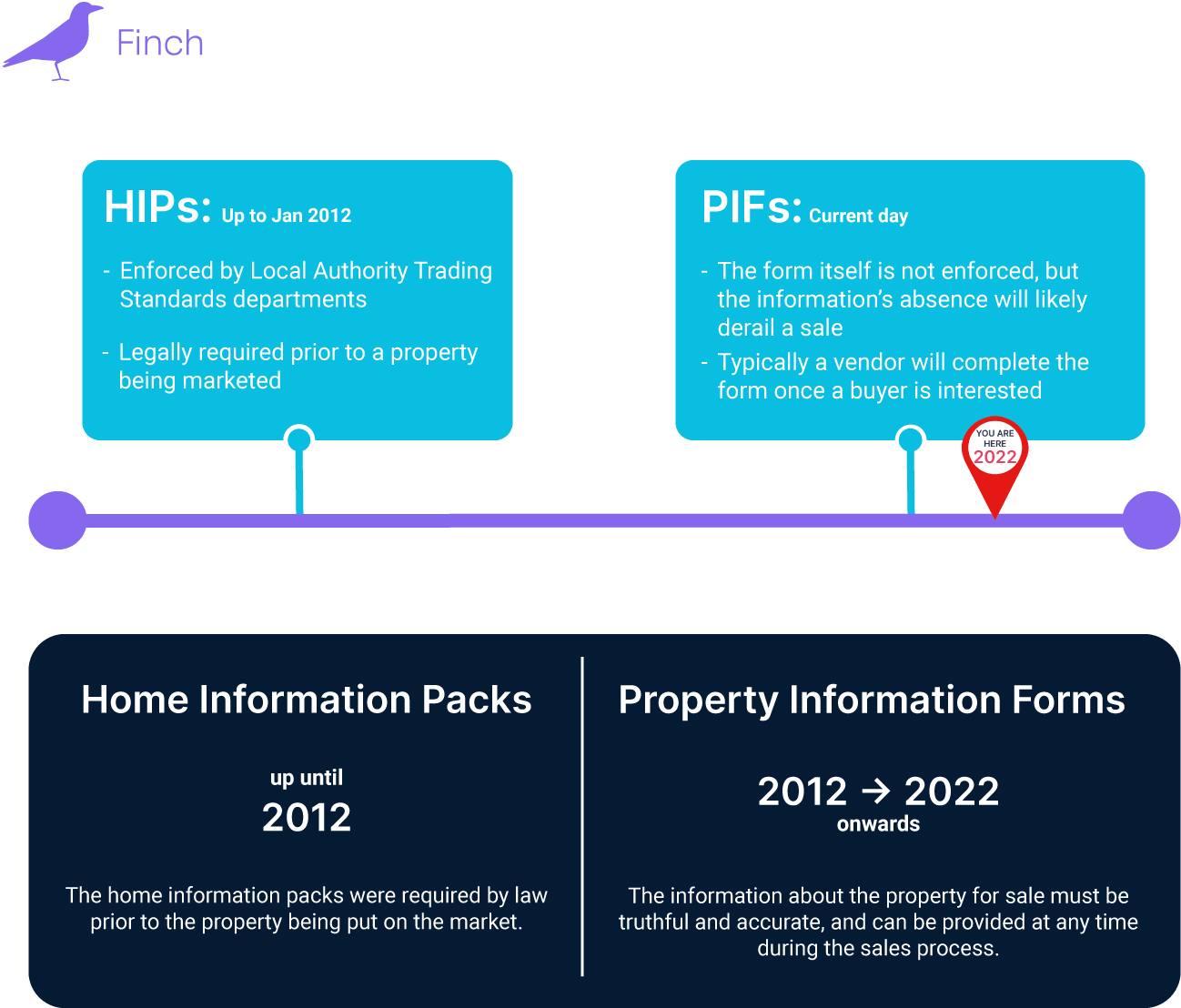Is the Property Information Form a resurrected Home Information Pack?
For those who have been selling and letting residential properties over the past couple of decades, they will remember the Home Information Packs (HIPs), sometimes called a sellers pack. These were created during the coalition government and were formally repealed by the Localism Act 2011 on the 15th January 2012.

One element of the HIP has continued on to current day though, as the Minimum Energy Efficiency Standards which continue to be developed within the now required Energy Performance Certificates (EPCs).
HIPs were a legal requirement regulated by a governing body and were to be completed prior to a property being marketed. Property Information Forms are a set of informative data points which will likely be requested by a solicitor for a buyer to complete a sale.
These data points include information on boundaries, commodities and neighbourly situations. And whilst the information is no longer a legal requirement and is therefore distinct from HIPs, it is information which will likely derail a sale should it remain absent.

What is the Property Information Form?
The Property Information Form (PIF) is one of eight transaction forms known as TA Forms. The form relevant to freehold property sales is the TA6 (or transaction Form 6). These forms have been created by The Law Society and cover multiple purchase options. TA6 is designed for the vendor to provide detailed information about the property to the buyer
TA6 (PIF as we will continue to call them) includes the following information:
- Property boundaries
- Disputes and complaints
- Notices and proposals
- Alterations, planning and building control
- Guarantees and warranties
- Insurance
- Environmental matters
- Rights and informal arrangements
- Parking
- Additional charges
- Occupiers
- Services
- Connections to utilities and services
- Transaction Information
This is a large body of work for a vendor. The PIF is a significant challenge for any agent encouraging their vendor to complete the form prior to marketing the property. A typical roadblock here will be the vendor’s desire to have a deal secured prior to addressing the full PIF. There are however some must-haves for the marketing materials.
The good news for agents is that this form in contrast to the HIP, is divisible. If the information gathered by the PIF isn’t provided at the point of marketing the property, it will simply be requested by the buyers solicitor later. There is information which should be used to hook the interest of a potential buyer and information which only becomes relevant to the buyer at offer and sale progression.
For example, at the initial point of interest, a buyer is likely to want to know whether or not the property is a listed building, they may also be interested in its energy efficiency rating or in its boundaries, but less concerned with information such as the absence of historical fishing rights on the land (of their 1980’s urban mid-terrace)… section 8.5. The specific peculiarities of a property can come later!
Is there a Property Information Form for both Sales and Lettings?
There are a number of different transaction forms provided by The Law Society in addition to the PIF:
- TA4 – Required commonhold information
- TA6 – Property information form (likely to be needed for every purchase)
- TA7 – Leasehold information form
- TA8 – New home information form
- TA9 – Commonhold information form
- TA10 – Fittings and content form
- TA13 – Completion information and requisitions on title
- TA15 – Commonhold information request
All of these forms apply to the sales conveyance process.
In lettings, the Property Information Questionnaire (PIQ) serves a similar purpose to the PIF. However, whilst the absence of the PIF during the sale process will likely halt the sale completely, a missing PIQ would likely have no effect on the tenancy proceeding. It is possible, that a tenant facing adverse or mis-sold conditions, might suggest a breach of section 10.8 of the Unfair Commercial Practices Directive. Below are two helpful excerpts from SHELTER and GOV.UK showing how a high degree of clarity about a property (sold or let) is essential.
Who’s responsible/ accountable for the details provided in the Property Information Form?
The vendor is responsible for recording the information correctly but assistance is offered through many avenues, not least of all by The Law Society. The vendor is the one who sign the contracts and is responsible for ensuring that the buyer has accurate information to make a purchasing decision. If an agent or third party was to provide information on behalf of the vendor, it would still be the vendor signing the information off.
One example of a third party’s actions resulting in a successful claim against a vendor is in Strover v Harrington [1988]. A farmhouse property was described as having mains drainage when the property did not have mains drainage. The vendor did in fact give the right information to the buyer’s solicitor, who failed to pass this information on to the buyer. It was held that the loss to the buyer was not a result of misrepresentation but the solicitor was likely liable for professional negligence.
Should an agency encourage a seller to complete the Property Information Form prior to an offer?
The major benefit of Property Information Forms is that they offer transparency for the property being sold. There is a difference, however, between what is helpful in marketing the property, and what is a need-to-know for the buyer to complete the sale.
Best practice might be to divide the form into two sections, for the vendor to complete each one at distinct stages of the sales process. The first of these two sections being the questions aimed towards marketing the property. And the second being the finer details a buyer is going to need to make an informed purchasing decision.
Even with the form divided in two, it’s advantageous for a seller to provide the information early because not providing the information, could be a reason for a sale either not being perused or worse, for a sale falling through. Some suggested sections to include in a marketing-focused part 1 might be:
- The situation with ownership details and any associated charges
- If there are any new buildings, conversions or alterations to the property
- The timings of the sale
- If there are any potential liabilities with the property
- If the property has solar panels
- Whether there are any protected buildings or trees
- What are the rights for access, services and are there any shared facilities
- Reporting the situation with parking, flooding and any current and historical disputes
In a market where supply is out-stripping demand, the availability of more information demonstrates that the seller is really serious. According to a report by Quick Move Now, 31% of property sales fell through during the middle part of 2022. This looks to be up from a 2018 report by HOA’s YouGov study where the number was significantly lower at 20%.
As an agent, it is worth addressing the barriers your vendors may present as to why they don’t want to complete the PIF, or parts of the PIF sooner. Largely, this is going to be down to the time investment to complete the form, the time restraints in preparing to move, or their perception of the form’s importance.
Dividing the form up and educating the vendor that an informed buyer is more likely to complete, will help everyone secure a sale sooner.

Daniel Slight
Dan has nearly a decade within tech production and marketing, with a specific interest in tech start-ups. This has followed a career in the property sections for local and national media brands. At Finch, Dan is responsible for product and brand marketing and away from the office, he can normally be found either in his kayak or cycling the Peaks.








